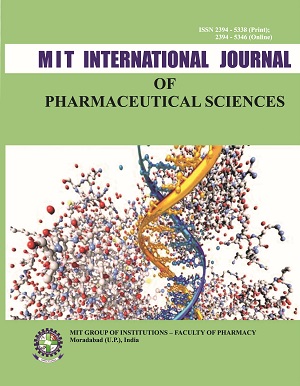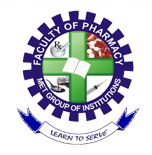
MIT INTERNATIONAL JOURNAL OF PHARMACEUTICAL SCIENCES (MITIJPS)
ISSN 2394-5338 (Print); 2394-5346 (Online)
Volume 7, Issue 2, 2022
This is open access Journal
Global Impact factor:0.565
SJIF Impact factor: 5.296
MITIJPS
Volume 7, Issue 1, 2022
Review Article
Potential targets for effective theraPeutic intervention for the treatment of diabetic nePhroPathy
aanchal gupta*, amaan moazzam
Moradabad Educational Trust Group of Institutions Faculty of Pharmacy, Moradabad, Uttar Pradesh, India.
*Corresponding Author: Tel. No. : +91 7500242459, Email: gupta3043aanchal@gmail.com
Abstract
Diabetic Nephropathy (DN) a disease which causes renal harm along with diabetes. DN is a very popular and progressive disease which impact on both (type1 and type2) categories of diabetes bearing patients. In last few 10 years diabetic nephropathy has successfully become a global threat for the genesis of end stage renal disease. however, it’s important to know that almost 70% diabetic bearing patients may develop diabetic nephropathy. It’s a bit tedious to tackle DN because a numerous number of attributes are composed in the pathological process of diabetic nephropathy like hyperglycemia, triggering of protein kinase pathway, role of endothelin, initiation of sodium glucose cotransporter 2 and many more. Diabetic Nephropathy is divided into 2 stages. microalbuminuria (level of albumin ranging from 30 to 300mg/24hr) and macroalbuminuria (level of albumin ≥300 mg/24 h). identiffcation of microalbuminuria is to be tested yearly and initial 5 years after conffrmation in type 1 diabetes and indigent metabolic control. In type 2 diabetic patient, identiffcation is performed at conffrmation and annually from that point. This review article is mainly concern with the aspects regarding initiation and continuation of diabetic nephropathy along with its clinical signs and symptoms which can determine its lethalness among patients who are prior at risk for causing this disease and advanced therapeutic targets and preventive measures that have been identiffed recently to combat DN and overcome from it by applying nascent possible treatments and taking preventive steps before DN ceases us.
Keywords: Diabetic Nephropathy, Endothelin, Microalbuminuria, Macroalbuminuria, Sodium glucose cotransporter 2
Review Article
Computer Aided Drug Design: A Review
Hansika Bansal
Moradabad Educational Trust Group of Institutions Faculty of Pharmacy, Moradabad, Uttar Pradesh, India.
*Corresponding Author: Tel. No. : +91 7900960891, Email: hansikabansal10@gmail.com
Abstract
Once upon a time, the method of drug discovery and development was considered as very difffcult and time taking but with the modernisation of computational tools and methods, it’s been accelerated. CADD (computer aided drug design) is really a very powerful tool nowadays due to its usefulness in making various processes easier and faster. Among various approaches of CADD structure-based drug design and ligand-based drug design approaches are known to be very efffcient techniques in drug discovery and development. The foremost fundamental goal in drug design is to predict whether a given molecule will bind to a target or not and even if it does so, then how strongly. In this review article, I even have given a summary of computational approaches, which is creative process of ffnding novel leads and aid within the process of drug discovery and development research. This review is open for corrections and updates.
Keywords: Computer aided drug discovery, Ligand-based drug design, Drug discovery and development, Target
Review Article
Treatment of liver diseases from herbal drugs
Anjali Verma*, Ayushi Saxena
Moradabad Educational Trust Group of Institutions Faculty of Pharmacy, Moradabad, Uttar Pradesh, India.
*Corresponding Author: Tel. No. : +91 9917321653, Email: anjaliverma31814@gmail.com
Abstract
The Treatment of Liver Diseases, Herbal Drug are utilized to assume essential part from antiquated history. The utilization of restorative plants and their concentrates are utilized to inclined liver infections from the previous decade. The utilization of natural solutions for liver defensive exercises has turned out to be more well known. The 21st century has been moving towards home grown details for treating liver illnesses via cautiously consolidating with the qualities of present-day medication with conventional idea. The spices with dynamic constituents are utilized to treat liver infection of known, obscure, or numerous causes. The Synergistic impact of various Herbs with dynamic segment must be created. The home-grown medications are valuable in the treatment of infective, poisonous, and degenerative illnesses of the liver. In Indian systems of medicine using more than 87 Indian medicinal plants like Silymarin, Azadirachta indica (Neem), Curcuma longa (Haldi), Ocimum tenuifforum (Tulsi), Piper longum, Glycyrrhiza glabra (Liquorice) are used to cure chronic liver diseases and jaundice etc Injury of liver cell is brought about by different damaging synthetic substances like carbon tetrachloride (CCl4), anti-toxins, chemotherapeutic specialists, thioacetamide (TAA), microorganisms, unreasonable utilization of liquor and overdosing of medication are utilized to ffx constant liver infections and jaundice and so on. The clinical preliminary was led to decide the viability of natural medication for treatment of liver infections. In present time the natural medication is clinically assuming a fundamental function with no side compelling the treatment of liver diseases.
Keywords: Liver diseases, Hepatoprotective, Clinical Trial, Drug(s), Plants, Conventional
Review Article
ROLE OF OXIDATIVE STRESS IN THE PATHOGENESIS OF NEURODEGENERATIVE DISEASES
Mansi Rastogi
Moradabad Educational Trust Group of Institutions Faculty of Pharmacy Moradabad 244001, Uttar Pradesh India.
*Corresponding Author: Tel. No. : +91 7351773390, Email: rastogimansi60@gmail.com
Abstract
Alzheimer’s disease, Parkinson’s disease, and amyotrophic lateral sclerosis (ALS) are all neurodegenerative conditions that affect an increasing number of senior people. A gradual loss of neurons, impaired motor or cognitive functions, and aberrant protein buildup are hallmarks of many disease disorders. In organs that require a high level of energy, such as the heart, muscles, brain, or liver, mitochondrial dysfunction is a common characteristic of the ageing process. Synaptic plasticity and neurotransmitter synthesis all rely on the mitochondria, which supply the energy needed for most cellular functions. Due to the brain’s high oxygen consumption, inadequate antioxidant defences, and high polyunsaturated fat content, it is particularly vulnerable to oxidative stress and damage. To sustain neuronal integrity and survival, the necessity of protective mechanisms, such as antioxidant defences, cannot be overstated. This comprehensive perspective will help to better understand the connection between mitochondrial oxidative stress and neurodegenerative disorders.
Keywords: Alzheimer’s disease, Amyotrophic lateral sclerosis, Mitochondrial dysfunction, Antioxidant
Review Article
ROLE PLAY OF HERBAL INGREDIENTS IN THE WORLDWIDE AILMENT OF DIABETES MELLITUS
Sakshi Guptaa*, Komalpreet Kaura, Neeru Dangwalb, Akshat Choudharyc
a*DSB campus, Department of Pharmaceutical Sciences, Kumaun University, Nainital, Uttarakhand, India.
bSanskar College of Pharmacy and Research, Ghaziabad, Uttar Pradesh, India.
cInstitute of Pharmaceutical Research, GLA University, Mathura, Uttar Pradesh, India.
*Corresponding Author: Tel. No. : +91 8449641654, Email: sakshig41654@gmail.com
Abstract
Diabetes Mellitus is one of the major endocrine disorders affecting nearly 10% of the worldwide population and now a days it’s becoming a key issue for concern. In this review article, we studied the hypogycemic activity of different medicinal drugs. We mainly focused on the four medicinal plants i.e: – Gymnena Sylvestre, Salacia Reticulata, Swertia Chirata, Pterocarpus Marsupiam. In this the active constituents which we obsevered for the hypopgylcemic activity were Gymnenic acid, Mangiferin, Kotalanol, Salacinol, Swertiamarin, Amarogentin, Liquiritigenin. These phytochemical constituents behaved as antidiabetic agents due to the interaction with multiple targets including alpha glucosidase, GADPH, Sodium symporters, PPAR-g expression, amalyse.
Keywords: Hyperglycaemia, Obesity, Hyperpigmentation, Alpha-glucosidase, Immunoprotective, Anti-hyperlipidemic
Review Article
Recent Researches on D-Pinitol
Darakhshan Parveen*
Department of Pharmaceutical Chemistry, Delhi Pharmaceutical Sciences and Research University, Mehrauli – Badarpur Rd, Sector 3, Pushp Vihar, New Delhi-110017, India.
*Corresponding Author: Tel. No. : +91 8126463330, Email: suhana.dk@gmail.com
Abstract
D-pinitol or 3-O-Methyl-D-chiro-inositol is a member of the ffavonoid family. It is a hexahydroxy cyclohexane whose 3rd position is substituted by a methyl group. It exhibits a wide range of pharmacological activities such as antidiabetic, anticancer, anti-osteoporosis, anti-inffammatory, antioxidant, hepatoprotective and immunomodulatory activity. Azole Nucleosides Derivatives of D-Pinitol is used as an anti-tumour agent. D-Pinitol or Methyl Inositol is also in clinical trial for Alzheimer’s Disease (AD) / Dementia.
Keywords: d-pinitol, Azole derivatives, Bougainvillea spectabilis, Methyl Inositol, Clinical Trial
Original Article
HERBAL APPROACH FOR THE MANAGEMENT OF PSORIASIS
Nishat Afza, Ramesh Kumar Gupta, Kislaya Mishra*
aDepartment of Pharmacology, Hygia Institute of Pharmaceutical Education and Research, Lucknow-226020, Uttar Pradesh,India.
*Corresponding Author: Tel. No. : +91 7800020461, Email: kisalayamishra@yahoo.in
Abstract
Psoriasis is a common persistent, non-communicable skin illness that is inffuenced by genetic, immunological, and environmental factors. Pathophysiology of the disease includes mainly activated Tcells into the dermis and release of cytokines from keratinocytes that lead to rapid growth of skin cells.Psoriasis is an inffammatory skin condition that causes viable factors including skin trauma,infection emotional stress,alcohol labuse, medicines there are various kinds of psoriasis such as plaque psoriasis guttate psoriasis ,scalp psoriasis,nail psoriasis,psoriatic arthritis,ffexural psoriasis. Psoriasis can be treated with a variety of methods, including light therapy, topical medications, systemic medicines, and a homoeopathic approach.. the therapeutic agents that either modulate the immune system or normalize the differentiation of psoriatic keratinocytes.
Keywords: Psoriasis, Inffammation, Plaque, Psoriasis, Chronic Skin Disease
